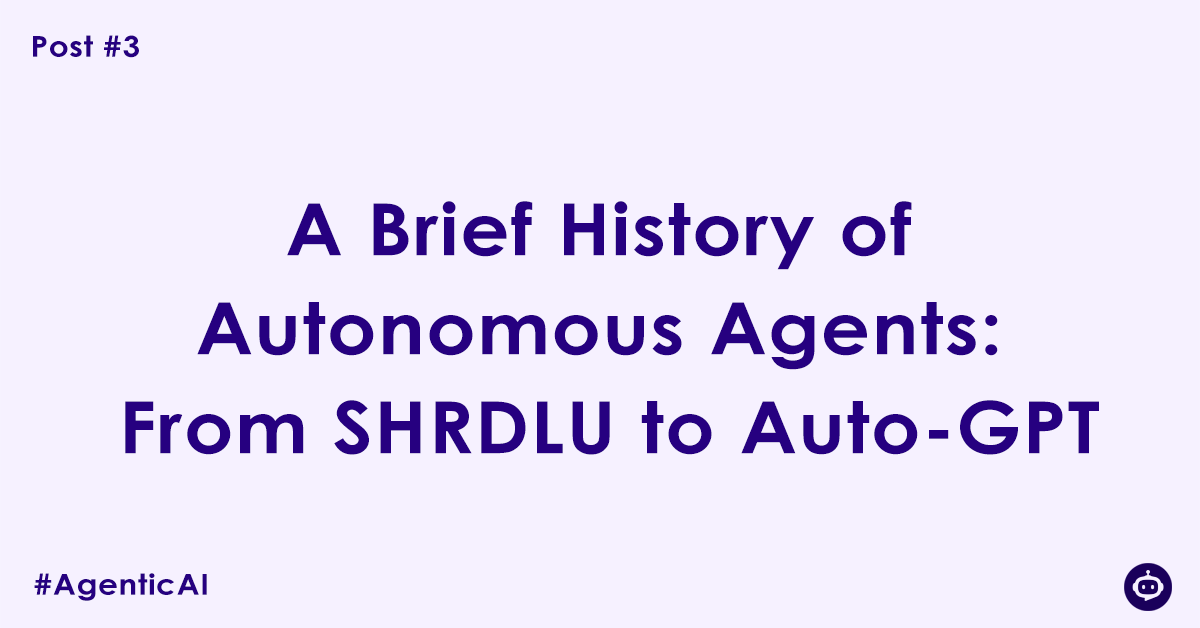To truly appreciate the current “dawn of Agentic AI,” it’s essential to understand the intellectual lineage that brought us to this point. The concept of an “autonomous agent” isn’t new; it has roots deep in the early days of artificial intelligence research. Tracing this history, from rudimentary rule-based systems to today’s sophisticated LLM-powered entities, provides crucial context for where we are and where we’re headed.
Early Seeds: Logic, Planning, and Micro-Worlds (1960s-1980s)
The idea of a machine capable of understanding goals and executing actions can be traced back to some of AI’s foundational projects.
One of the most iconic early examples is SHRDLU (1971), developed by Terry Winograd at MIT. SHRDLU operated in a “blocks world” – a simplified virtual environment containing various colored and shaped blocks. Users could give SHRDLU commands in natural language (e.g., “Pick up the red block,” “Put the blue pyramid on the green box”). SHRDLU could not only understand these commands, plan a sequence of actions to achieve them, and execute them, but also answer questions about its actions and the state of the blocks world.
While incredibly limited in scope, SHRDLU demonstrated the possibility of a system that could:
- Understand natural language goals.
- Model its environment.
- Plan a series of steps.
- Execute actions.
- Engage in dialogue about its process.
These were the nascent elements of agentic behavior. Other research in symbolic AI, expert systems, and planning algorithms during this period continued to explore how machines could reason about actions and consequences.
The Rise of Distributed AI and Multi-Agent Systems (1980s-1990s)
As AI research matured, the focus expanded beyond single agents to how multiple agents could interact and collaborate. The field of Distributed AI (DAI) and subsequently Multi-Agent Systems (MAS) emerged.
Key concepts during this era included:
- Intelligent Agents: Defined more formally as autonomous entities that perceive and act upon their environment.
- Agent Architectures: Developing frameworks for how agents sense, reason, and act (e.g., subsumption architecture by Rodney Brooks for robots).
- Communication Protocols: How agents exchange information and coordinate their actions to achieve collective goals.
Practical applications began to appear in areas like manufacturing control, air traffic management simulations, and even early digital assistants that could manage schedules or filter emails based on user preferences. While not as “intelligent” as current LLMs, these systems were fundamentally about agents performing tasks with some degree of autonomy within defined environments.
The Internet Age and Software Agents (1990s-2000s)
With the explosion of the internet, the concept of “software agents” gained prominence. These were programs designed to perform specific tasks on behalf of a user, often involving searching, filtering, or monitoring information across networks. Examples included:
- Web Crawlers/Spiders: Agents that autonomously navigate the web to index content for search engines.
- Shopping Bots: Agents that compared prices across different online retailers.
- Personal Assistants: Early versions of digital assistants that could manage email, calendars, and news feeds.
While many of these were essentially automated scripts, they embodied the core idea of an agent: an entity performing actions in an environment (the internet) to achieve a user’s goal (finding information, comparing prices).
Machine Learning and Reinforcement Learning Agents (2010s-Present)
The deep learning revolution dramatically shifted the capabilities of AI agents. Instead of being solely reliant on explicit rules or symbolic representations, agents could now learn complex behaviors directly from data and experience.
Reinforcement Learning (RL) became a cornerstone for developing highly autonomous agents, particularly in game-playing and robotics. Agents learn by trial and error, receiving rewards for desired behaviors and penalties for undesired ones.
- DeepMind’s AlphaGo (2016): An RL agent that famously defeated the world champion Go player, demonstrating unprecedented strategic planning capabilities.
- Robotics: RL agents learning to grasp objects, navigate complex terrains, and perform dexterous manipulations.
These agents showcase truly autonomous learning and decision-making within highly dynamic and often unpredictable environments.
The LLM Era: Auto-GPT and Beyond (2020s)
The arrival of powerful Large Language Models (LLMs) like GPT-3, GPT-4, and others has ignited the current fervor around agentic AI. LLMs provide an unprecedented capability for reasoning, planning, and natural language interaction, becoming the “brain” of sophisticated agents.
Auto-GPT (2023), while not a product from a major lab, became a viral sensation for demonstrating the potential of LLM-based agents. Given a high-level goal, Auto-GPT could:
- Use an LLM to break down the goal into smaller tasks.
- Self-critique its own outputs.
- Access the internet for research.
- Execute code.
- Save information to memory.
- Iterate on its process until the goal was achieved.
This demonstrated a level of autonomy, planning, and tool-use that felt truly transformative for a consumer-facing AI. Other open-source projects and research initiatives quickly followed, building on these concepts.
The Path Forward
From SHRDLU’s block world to Auto-GPT’s internet-spanning ambitions, the journey of autonomous agents has been one of continuous expansion in capabilities, complexity, and real-world applicability. We’ve moved from constrained, rule-based systems to flexible, learning entities powered by vast neural networks and advanced reasoning. Understanding this history helps us recognize that while the current advancements are groundbreaking, they stand on the shoulders of decades of dedicated research, paving the way for a future where AI agents become integral, proactive partners in almost every facet of our lives.
Author

Experienced Cloud & DevOps Engineer with hands-on experience in AWS, GCP, Terraform, Ansible, ELK, Docker, Git, GitLab, Python, PowerShell, Shell, and theoretical knowledge on Azure, Kubernetes & Jenkins. In my free time, I write blogs on ckdbtech.com
